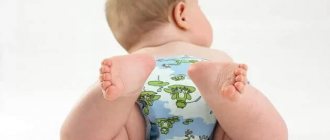Nutritional standards for a three-month-old baby
According to standards, babies at three months should drink 150-180 ml of milk or formula per feeding, this is 1/6 of the weight of a 3-month-old child. The amount of food in ml that a three-month-old baby eats during the day is equivalent both when breastfed and when fed with formula. As practice shows, children who are on guards eat more times a day than children who are on willows.
The fact is that a baby who feeds only on breast milk can suck very little milk from his mother’s breast at one time and will ask for food much more often than the same child eating formula. Artificial babies eat less often because the formula is much more nutritious, and they stay full longer.
Small child in mother's arms
If the baby is breastfed
At three months, the baby, as a rule, has already developed its own individual feeding schedule. The norm for feeding a three-month-old baby on guardianship is considered to be feeding 6-7 times a day and the child consuming up to one liter of mother's milk per day.
It is much more difficult to control the amount of food eaten during breastfeeding, since the mother cannot see how much milk the baby sucked in one feeding. Therefore, if there is a need to control this process, it is necessary to weigh the child on an electronic scale before feeding and after the baby has eaten.
Interesting. When feeding the baby in the morning, a mother needs to understand that she sleeps at night and, accordingly, does not eat food, so breast milk in the morning is not very high in calories. After breakfast, closer to lunch, the milk will become more nutritious.
At night, you should not take a long break between feedings, since it is at night that the hormone prolactin is produced, which stimulates good lactation.
Baby sucks mother's breast
When a child is on artificial nutrition
A three-month-old baby can already drink about 180 ml of the mixture at one feeding. During the day, the child eats 4-5 times during the day and 2-3 times at night, this is much less often than the newborn baby ate at first.
There are two methods for calculating the nutritional norms of a baby at three months. In order to calculate the average nutritional volume, you can use these methods simultaneously.
First method
To calculate how much a child should eat at 3 months, you need to multiply his body weight by 1/7, which will result in the average daily volume of the formula. Next, you need to divide the total volume of the mixture by the number of feedings per day, you will get a single dose that the child needs.
For example, the baby’s weight is 5,460 * 1/7 = 780 ml, this is food for one day. Next 780/5=156 ml. A child will need a total of 156 ml for one feeding.
In reality, it is very difficult for a mother to prepare such an amount of formula, since it is prepared right before giving it to the child. If 150 ml of the mixture was enough for the baby throughout the day, then by the evening, after active play, he will develop a strong appetite, and the same volume of mixture as during the day will not be enough. In this case, you can add another 25 ml to 150 ml, and the amount of mixture consumed will not exceed the average daily norm.
Second method
With this method, the child’s weight and height are taken into account. According to average statistics, a three-month-old baby should eat from 900 to 1050 ml of mixture per day. This norm is divided into the required number of feedings (usually 5-7 times a day).
For overweight children who are actively developing, the volume of formula will be different, not the same as for children with average body weight and height. Children with a body weight above average should eat 900-950 ml of the mixture per day.
Bottle and pacifier lie on the table
If the child is on mixed feeding
If a mother feeds her baby with breast milk and then supplements her with formula, then calculating the average daily amount of food for a three-month-old baby is quite problematic. An indicator that a baby fed both mother's milk and formula is full is its behavior. If the baby is vigorous, cheerful and sleeps soundly, it means he has enough nutrition.
With this type of feeding, you should first offer the baby a breast, first one, then immediately the second. The mother should do this so that while the child is very hungry, she first eats more nutritious and healthy food. If the mother sees that the baby is not full, then it is necessary to supplement him with formula from a bottle.
For your information. Depending on the amount of milk the mother has, the volume of formula required to supplement the baby may vary. In the third month of life it can vary from 25 to 120 ml.
Babies do not stay on this type of feeding for very long, for the reason that it is very difficult to suck milk out of their mother’s breast, and the mixture from the bottle gets into the mouth without any extra effort. Then the child prefers to drink formula from a bottle more and more often and stops taking the breast.
Baby drinks formula from a bottle
Formula feeding, how much should a 3 month old baby eat?
Artificial formula requires less than breast milk. It has more calories and takes an hour longer to digest. For convenience, there is a table on the packages of baby formula that shows the amount of baby food for each age.
In order to calculate how many ml a child eats at 3 months, you can use the formulas:
- The baby's age in days must be multiplied by 80.
- The baby's body weight in grams must be divided by 6.
The results obtained are the amount of food required per day. The final figures differ because they are approximate.
The main thing is that the amount of food per day is at least 800 ml and maximum 1000 ml. It is necessary not only to know how much formula a child eats at 3 months, but also to monitor his weight gain. Normally, the increase should be 800-900 g per month.
Transfer your baby to formula in extreme cases and always under the supervision of a pediatrician. If the baby is weak and does not feel well, then a change in diet is undesirable for him, as it becomes additional stress. The body's reaction to the transition varies.
For three-month-old babies, you need to choose an adapted or highly adapted mixture. This food is similar to mother's milk and is well absorbed.
When purchasing, you need to pay attention to the expiration date and proper storage of the product. If these conditions are violated, the mixture changes its composition, negatively affecting the baby’s health.
When choosing a baby food product, you need to study the composition. It should include:
- taurine,
- carnitine,
- vitamins,
- microelements.
Despite the fact that a milk substitute is ideal for a child in terms of age and composition, it may not be suitable for the body for individual reasons. In case of allergic manifestations and changes in the gastrointestinal tract, you should consult a doctor for further recommendations.
And another important nuance - the mixture for artificial feeding of a month-old baby is somewhat different in composition from the mixture that should be given at three months. Choose products appropriate for the baby's age.
Diet of a three month old baby
Complementary feeding at 4 months
Each child is individual, so the mother should choose the frequency of feedings independently or consult a pediatrician. This is especially true for infants on artificial nutrition.
One baby, thanks to his mother's nutritious milk, can be full and not ask for food for 5-7 hours, usually at night. Another little one wants to eat within three hours. Everything is strictly individual.
During the day
The three-month-old baby is already more awake and sleeps less. While awake during the daytime, the child studies the world around him, communicates with mom, dad and other relatives, but most often he eats according to his own schedule. The table below shows an approximate feeding schedule for a 3 month old baby.
Approximate feeding time for a baby during the day
| Feeding | Time |
| 1st feeding | from 9:10 to 9:40 |
| 2nd feeding | from 11:20 to 12:00 |
| 3rd feeding | from 15:20 to 16:00 |
| 4th feeding | from 19:00 to 20:00 |
Feeding times can change for a variety of reasons: getting up late, high-calorie foods, illness, and so on.
At night
At night, the baby should eat approximately three times: at 22:00, 1:30 and 3:30 am. This time is average and cannot be considered as a strict rule.
It often happens that the baby misses one or even two feedings at night. You should not wake him up; when the baby gets hungry, he will wake up on his own, only a little later.
Child drinks water from a bottle
The baby is constantly “hanging” on the chest
Very often, a baby likes to sleep under the breast: he is already asleep, but does not let his mother go. Usually, this is not a sign of low milk supply. The baby just really likes to be close to his mother. But there are also more complex cases.
Ekaterina, 25 years old, mother of five-month-old Egor: “At about 3 months I encountered a problem: morning feeding was so long that it turned into an afternoon snack, and then lunch. He seems to have had enough, but he doesn’t let me go, he smacks me once or twice for 5 minutes, swallows a little milk and goes back to sleep. You put him in his crib, and he cries again, looking for me.”
Causes
This behavior in breastfed children can begin at any age. But most often this is observed at 1 and 3 months. This is due to the lactation crisis.
There is a decrease in the level of lactation against the backdrop of the baby’s ever-increasing need for milk. Not having eaten his fill, he continues to suck and little by little gets the food he needs.
It is necessary to understand that children must satisfy their sucking needs completely. Therefore, you should not use radical pedagogical techniques, for example, showing who is boss in the house by putting the baby in the crib to cry alone. There will be no positive result from such actions.
What to do?
The way out of this situation is simple: give the little man what he wants. Let him suck as much as he needs. To free up your mother's hands for household chores, buy a sling: your hands are free and your baby is busy.
You can arrange to sleep together throughout the day and night. In this case, the mother will have the opportunity to rest and recuperate. And then energy will appear to improve lactation. And it’s worth involving relatives in household chores, who love to give advice.
Karina, 22 years old, mother of a 4-month-old girl: “I’ve heard a lot about slings, about their incredible convenience and benefits. But I was skeptical about them until we started having “hanging” on our chests. I wasn’t in a hurry to buy it for myself personally; I took it from a friend to try. And literally the next day I ran to buy it. I, like a kangaroo, did everything with her on my chest: I cooked food, cleaned, started the washing machine, and even danced.”
When to give your baby water
How much should a 6 month old baby sleep?
Whether a baby should be given water at three months depends on the type of feeding, as well as the baby’s health condition and climatic conditions.
When breastfeeding
Modern pediatricians do not recommend supplementing infants with water until they are six months old. As an exception, you can give the child a little water in hot summer weather, when the norm of liquid per feeding for a three-month-old child should be at least 200 ml. If you constantly put your baby to the breast, then breast milk can easily replace this norm, and this “risky” liquid will not enter the baby’s body.
According to studies, it turned out that water that enters the baby’s body helps wash away the protective mucus produced by the gastrointestinal tract. Along with water, third-party microflora can enter the immature intestine, because it is unrealistic to give a child extremely clean water at home.
Artificially fed
For babies who eat only formula, it is simply necessary to supplement their diet with clean water. Calculating your daily water intake is very simple. This is done at the rate of 50 ml per kg of child weight. For example, a baby weighing more than five kilograms should be given 250 ml of clean water per day. This volume does not include the water required to prepare the mixture.
Give one or maximum two teaspoons of water in between feedings or when waking up at night. It is extremely undesirable to exceed this norm, since increased water consumption can disrupt the water-salt balance in the baby’s body, because the baby’s stomach and kidneys are completely immature and remove water from the body for a long time. You should not give your baby water before feeding, as it can greatly reduce his appetite. Water is offered only freshly boiled and at room temperature. You cannot add sugar to it, as this can cause obesity, impaired carbohydrate metabolism and other serious consequences.
A 3 month old baby lies on a blue blanket in a white bodysuit
How to tell if your baby is full
Dill water for colic for newborns
With any type of feeding, if the baby receives a sufficient amount of food, then immediately after feeding he will fall asleep peacefully. Not only sleep is considered an indicator that the child is full. If the baby has sucked all the formula from the bottle or milk from the breast and does not sleep, but smiles, gurgles, and wants to play, this means that he is full and very happy.
Important! Breastfeeding should be done for at least 15-35 minutes. The interval between meals will depend on the nutritional value of mother's milk or formula.
If the baby is not full while breastfeeding, he drops the breast and begins to cry. The mother should make sure that there is no more milk in the breast with which she fed the baby, and immediately offer him another one. If there is not enough milk, then it is necessary to supplement the baby with formula.
A baby who receives enough breast milk gains weight well. If there is not enough food, the increase will be very low.
Average statistical increase rates for 3 months
| Options | Boys | Girls |
| Weight, gram | 600-1100 | 500-1000 |
| Height, cm | 3-2,5 | 3-2 |
| Chest and head circumference, cm | 2 | 2 |
If the baby is vigorous, cheerful and gaining weight very well, parents should not worry. You can make sure that your baby is really getting enough breast milk by doing a wet diaper test. To do this, you need to leave the baby for a whole day without a diaper and swaddle him in regular diapers.
If you get 12-18 wet diapers throughout the whole day, then there is no reason to worry, the baby’s nutrition is in perfect order.
How to properly organize a newborn's feeding schedule
Today, doctors advise feeding children on demand. If earlier children's doctors insisted that a baby should be put to the breast no earlier than three to three and a half hours after the previous feeding, now the situation has changed. But experts warn young mothers not to confuse hunger with the desire to satisfy the sucking reflex. The baby should not be at the breast 24/7. Normally, the baby eats every 2-3 hours and the number of feedings decreases as they grow older. If in the first two to three days of life the baby asked for the breast about 10 times a day. Then by two weeks the feeding schedule is getting better: during the day the child can wake up 5–6 times, and at night 1–2 times. Some children need less, for example, they can sleep peacefully at night and not ask for food.
Each mother decides for herself how to organize the feeding schedule: on demand or by the hour
How long a baby can stay at the breast depends on the baby. Some children are full in 15 minutes, while others take about 30-40 minutes. In this matter, everything is individual. But the mother should clearly know that she should not let her baby nurse for more than an hour. You need to try to distract the baby with something else.
Video: Doctor Komarovsky about the feeding regimen of newborns
Nutritional norms for children of the first year of life
All mothers understand that the health and normal development of the baby depends on good nutrition. Therefore, worries about whether the baby is eating enough do not leave many women. In order to be sure of the correct development of the baby, the baby is examined by a pediatrician once a month. The main criteria are the weight and height of the baby. The doctor will weigh and measure the child, compare the data with the figures at the time of birth and discharge from the hospital, and draw conclusions based on this.
Another criterion is the amount of urination and bowel movements. The wet diaper test is recognized by doctors all over the world and gives a clear answer: whether the baby eats enough milk per day. The number of times a baby goes to the toilet varies depending on age:
- in the first three days after birth, the baby can write only three times a day;
- by the end of the first week, the number of urinations increases and is 4–8 times in 24 hours;
- from the second week after birth, the baby goes to the toilet 12 or more times a day.
Pediatricians explain to parents that if a child pees 12 times between the ages of 14 days and 6 months, then everything is normal and he has enough milk. If the number of urinations has decreased to 8–10 times, the mother’s milk supply has decreased. But 6 or fewer wet diapers indicate that the baby does not have enough milk, so an urgent consultation with a pediatrician is needed.
The main indicator of a child’s adequate nutrition is monthly weight gain.
There are also different methods for calculating the amount of milk that babies need at different ages.
We find out the amount of milk needed using the Speransky method
This method is based on the child’s weight and the number of calories in milk:
- 1 liter of mother's milk contains about 700 kcal;
- from birth to three months, a child needs 125 kcal per kilogram of weight;
- from three months to six months there are 115 kcal per 1 kg of baby’s weight;
- in the second six months of life and up to 12 months - 105 kcal.
To calculate, we use the following formula: the baby’s weight in kg must be multiplied by the number of calories depending on the baby’s age. We convert the resulting number of calories into milliliters. As a result, we will get the required amount of milk that the baby should eat per day.
Calculation using Geubner's method
This method is based on the child’s weight: the amount of nutritional fluid required directly depends on the age and number of kilograms. It is quite accurate.
Table: Milk norms per day for children of the first year of life depending on body weight
No matter what formulas parents use to calculate the amount of milk, the numbers will be approximately the same
Shkarin method
The formula is quite simple: at 8 weeks a baby should eat at least 800 ml of milk. To calculate the amount of valuable liquid you need:
- for a baby under 8 weeks, take 50 ml each week;
- for children older than this age - add 50 ml of milk, but not every week, but every month.
If your child eats less than normal
Poor appetite in a child can be caused by any situation:
- Illness, for example, acute respiratory infection or stomatitis.
- Changed environment, such as moving, being away for a long time, not getting enough sleep.
- Climate change, especially intense heat in the summer.
- Changing the diet, switching to a different mixture. Or the mother ate something unsuitable for the child’s body, and he does not like the taste of the milk at all.
All these factors have a short-term effect on changes in appetite in infants. If the baby does not eat well for two days, then you should urgently consult a doctor.
Video
21009, Anti-colic gel heating pad with Happy Baby Velcro cover, olive
824 ₽ More details
21009, Anti-colic gel heating pad with Happy Baby Velcro cover, lilac
824 ₽ More details
Happy Baby Scooters









